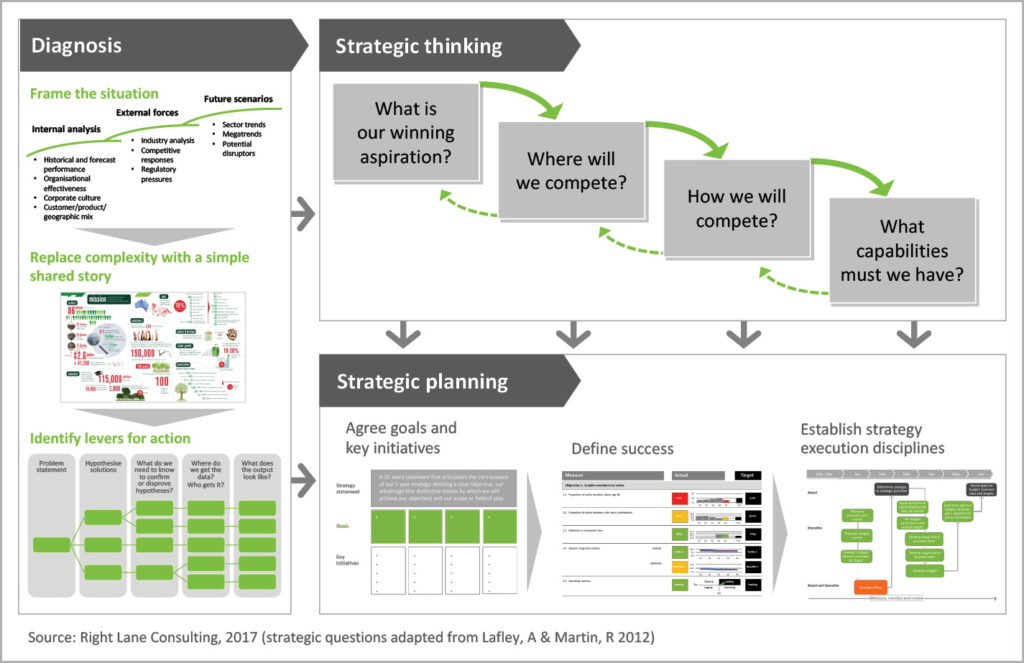The value of a robust diagnosis – be better prepared for next year’s strategy discussion
by Debbie Williams, Abhishek Chhikara & Dr Marc Levy
[testimonial]
Undertaking robust analyses of what’s happening in the world, the industry, and within organisations, is critical for clients to build an evidence base and a common reference point to draw upon when engaging in strategy discussions. We suggest that clients adopt a diagnostic approach that sorts data into patterns, and replaces the overwhelming complexity of reality with a simple story from which levers for action can be identified.
[/testimonial]

In the video strategic thinking before strategic planning, we describe our approach to strategy development. It involves asking unassuming but challenging strategic questions like: Where will we compete? How will we win? and What capabilities do we need to build? (Levy 2016). We ask clients to spend time ‘upstairs’ thinking about these questions, and, only when they’ve been satisfactorily answered, ‘move downstairs’ into strategic planning discussions covering goals, measures and priority initiatives. This sequence is shown in the chart below and this link (Strategic thinking before strategic planning).
While these two steps are critically important they are generally not sufficient. Preceding strategic thinking and planning – which frequently comes to a head at board and executive team strategy workshops – we encourage clients to undertake robust analyses of what’s happening in the world, their industries and their organisations, so that they have an evidence base and a common reference point to draw upon.
This sounds obvious enough, but over hundreds of strategy and planning engagements we’ve found that it’s common for the analysis phase to be foregone or given short shrift. Leaders don’t always see the value in it. Why? Only recently one of the exec team has done some strategic analysis; a consulting firm’s report includes a section on industry analysis; an external report or some market research traverses some of the ground; leaders may believe that their senior teams already know what they need to know.
 This reminds us of an Indian parable of four blind men walking through a forest who come across an elephant. Each blind man feels a different part of the elephant’s body and describes the elephant based on their experience. One feels the trunk and describes it as a snake, another feels a leg and describes it as a pillar. What happens next depends on who is telling the story. In some versions, the men suspect the others and come to blows. In another version, they stop talking, start listening and collaborate to ‘see’ the full elephant.
This reminds us of an Indian parable of four blind men walking through a forest who come across an elephant. Each blind man feels a different part of the elephant’s body and describes the elephant based on their experience. One feels the trunk and describes it as a snake, another feels a leg and describes it as a pillar. What happens next depends on who is telling the story. In some versions, the men suspect the others and come to blows. In another version, they stop talking, start listening and collaborate to ‘see’ the full elephant.
Richard Rumelt, in his book Good strategy, bad strategy, calls this analysis a diagnosis and notes that ‘an especially insightful diagnosis can transform one’s view of the situation, bringing a radically different perspective to bear’. And with radically different perspectives can come different opportunities.
Consider these recent examples from our work:
- A financial services organisation realised that taken for granted assumptions about the demographic profile of its membership were incorrect, leading to a reappraisal of its marketing programs.
- A representative organisation identified that its growth would come from industries and member cohorts that it was not explicitly targeting.
- A government enterprise discovered that long term trends in its financial performance gave it less time to change its business model than it previously thought.
- A deeper understanding of a retail business’s stakeholder intentions led to a change in the way it framed its strategic options.
- A facilities manager came to the conclusion that its prospects would be enhanced by privileging one type of customer over another.
Strategic Facilitators approach creates strategic clarity

We encourage clients that are unsure of the merits of a diagnosis to consider these questions:
- Is there an opportunity to identify a handful of hitherto unknown, strategically material insights among the overwhelming morass of analysis that is typical within organisations today?
- Will everyone bring the same understanding of the organisation’s performance and health (Davis, 2005), situation and prospects to the strategic thinking and planning discussions?
- Does the organisation have a contemporary ‘house view’ about how changes in the world will impact the organisation and its business model?
We suggest that clients adopt an evidence-based approach to discussing the elephant in their boardroom. One that links data into patterns, and replaces the overwhelming complexity of reality with a simple story from which levers for action can be identified.
References
Davis, I 2005, How to escape the short-term trap, McKinsey & Company, viewed 8 December 2017,
< https://www.mckinsey.com/global-themes/employment-and-growth/how-to-escape-the-short-term-trap>
Kaplan, R & Norton, D 2008, Execution premium: linking strategy to operations for competitive advantage, Harvard Business School Publishing, Boston
Lafley, A & Martin, R 2012, Playing to win: How strategy really works, Harvard Business Review Press, Boston
Levy, M 2016, ‘Strategic thinking before strategic planning’, Right Lane Review, May
Rumelt, R 2011, Good strategy, bad strategy: The difference and why it matters, Crown Business, New York
Want to know more?
For more information on how our facilitators can help you with your next Board, Executive Team or staff workshop, meeting or offsite, please contact us below or call the office on 03 9428 8817.
Contact us
© 2017 Strategic Facilitators by Right Lane Consulting
